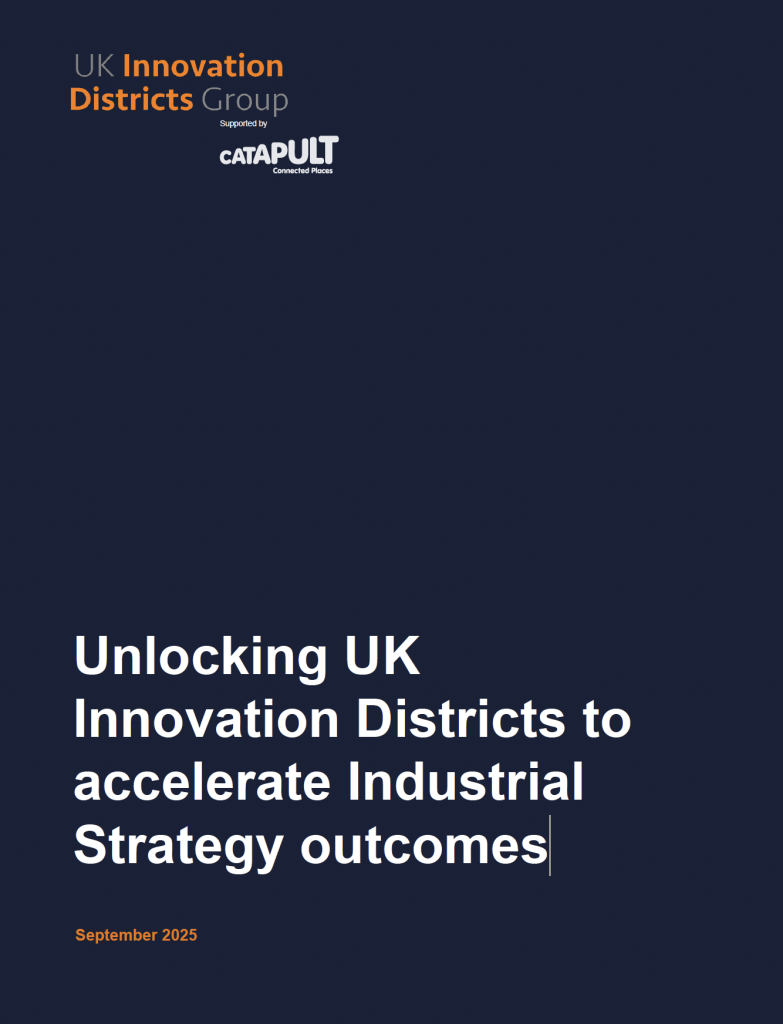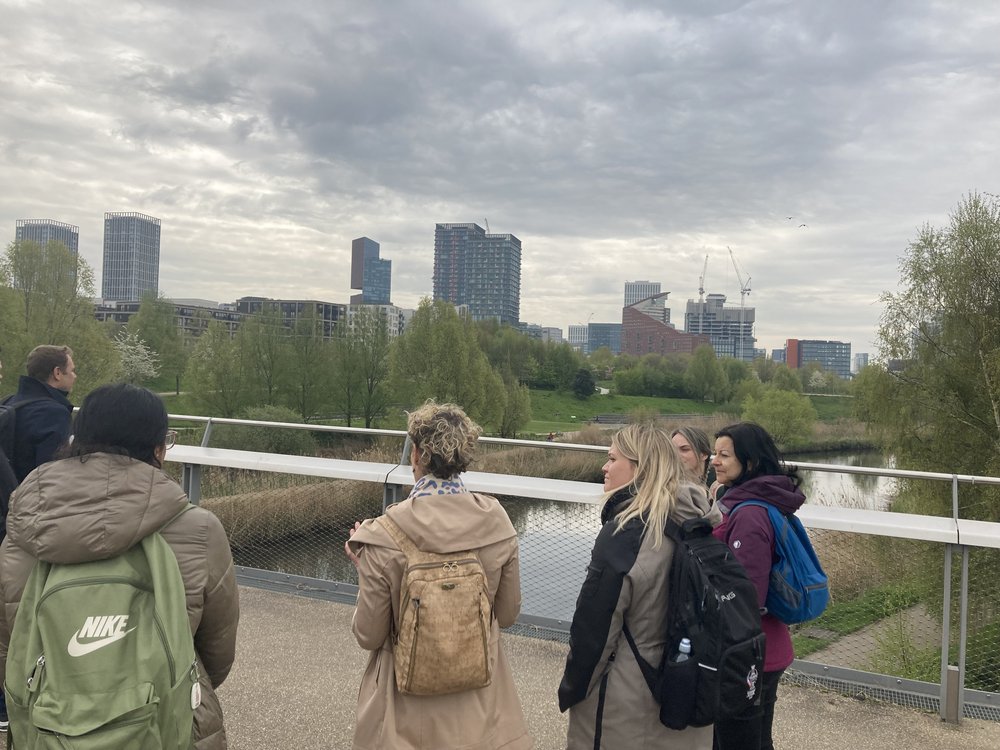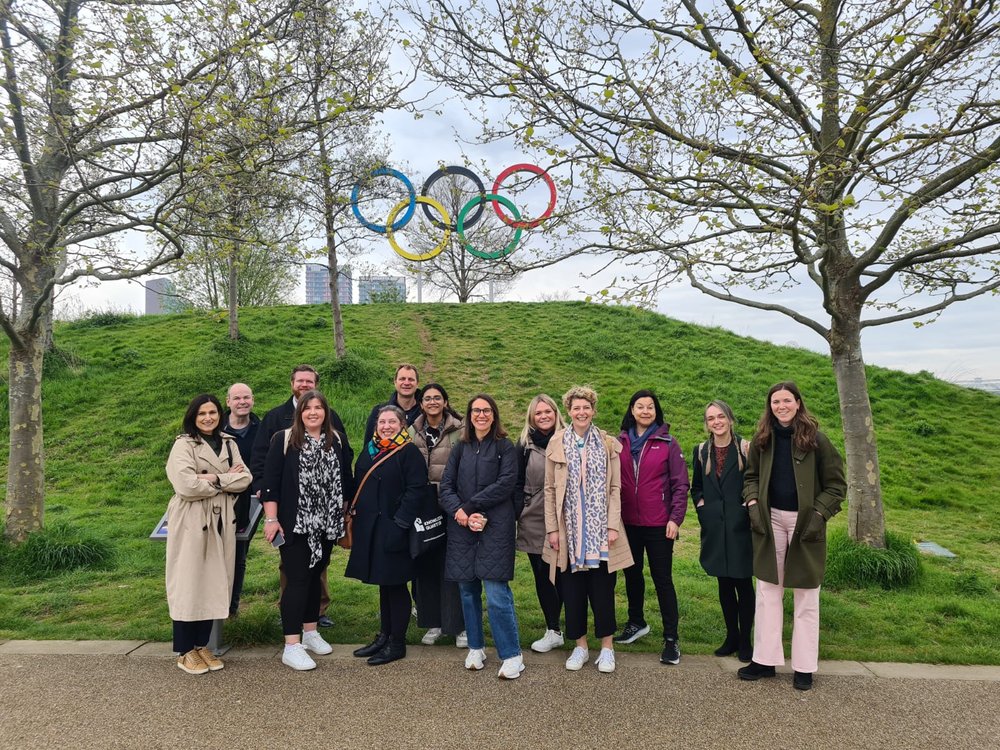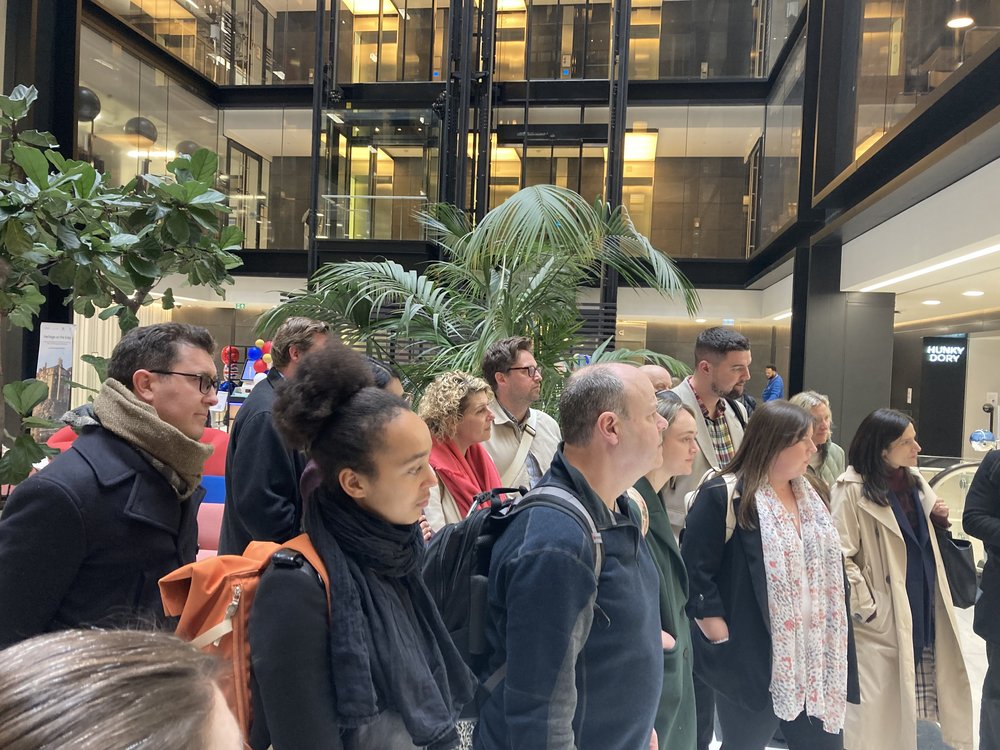The UK Innovation Districts Group (UK IDG) has today published its latest action paper, highlighting the vital role innovation districts play in delivering key elements of the UK’s Industrial Strategy.
Developed in collaboration with industry leaders, universities, and local and regional government, the report sets out a series of practical recommendations to accelerate the growth of innovation districts across the UK. It recognises their unique role in translating research into commercial opportunities, scaling businesses, and fostering inclusive, sustainable economic development.
Recommendations in the paper are framed around three themes:
- Enabling more investment into innovation districts
- Building more partnerships across the UK
- Strengthening local capacity to support, scale and commercialise innovation
The paper calls for a step-change in partnership building, leadership, and coordination between government, academia, industry, and investors to unlock the full potential of innovation districts as strategic economic infrastructure.
The UK IDG is proud to have partnered with Arup, an Associate Member of the Group, which has generously supported the development of this report.
This action paper is also an invitation for further collaboration. With momentum building and growing policy alignment, now is the time to act. The UK IDG extends its thanks to the many contributors who have already helped shape the recommendations through meetings and roundtables, and welcomes further engagement with them and others who would like to get involved.

Unlocking UK Innovation Districts to accelerate Industrial Strategy outcomes
How do we better understand and measure the value of innovation districts?
The social and strategic value that Innovation districts can offer to their communities, cities and countries is starting to be recognised but is notoriously hard to measure.
Robert F. Kennedy famously said that GDP measures “everything except that which makes life worthwhile”.
Yet much of the standard measures of success for innovation activity and innovation clusters tend to be heavily skewed towards similarly narrow indicators such as GVA, no. of jobs, no. of patents etc. Individually, there is nothing wrong with using such measures. But they don’t give us a collective or full picture of the value being generated.
How then, can we attempt to establish a more holistic value assessment of innovation districts in situ? How can we better evidence the whole value return they contribute to the places in which they are embedded? And how do we show this over different timescales and geographical scales in a meaningful and more standardised way that allows us to learn deeply about each place but also draw trends and learning between places?
These were some of the very questions that the UK IDG set out to answer this year. The development of impact measures for Innovation districts became our primary research enquiry for 2023 – following on neatly from our previous research commission in 2022 on The Case for Inclusive Innovation in the UK.
The case for why we need this sort of thinking is increasingly clear and is driving renewed focus on measuring the impact of innovation districts. Public, academic partners and increasingly private sector partners all wish to qualify and demonstrate the socio-economic value return of investing in Innovation Districts. Investors are looking for tangible measures to assess and compare innovation districts. City and district leaders need to demonstrate progress and potential to prospective funders, tenants and backers – as well as crucially to local businesses and residents.
So, there is a critical need to understand how best to frame success, gather data, and monitor progress. For this reason, the UK IDG with funding from CPC, commissioned The Business of Cities to undertake this work with the aims of:
- Producing a deep data dive for member district
Robust and relevant data points that give a fuller read on the status and value of each Innovation District in situ. Go beyond standard GVA or occupancy stats to include a blend of metrics that work across the three interrelated value themes of: Innovation, Place & People. Develop a framework that shows change over time and geography which helps isolate the added value of the innovation district in relation to its context. - Create a more consistent approach to place-based innovation value metrics
Establish a more unified model for UK Innovation districts to help spot common patterns and trends and learn with each other. - Use evidence to inform conversations
Use this evidence base to have focused conversations with city, regional and national government policy makers. Specifically linking into the UK Innovation cluster mapping work and thinking through broader applications connected to Innovation accelerators and Investment zones for example.
This work consisted of a global review informed by the UK IDG’s experiences and data architecture specialists. It also analysed the most appropriate blend of publicly vs privately available data sources, quantitative vs qualitative research work – with clear rational and guidance for each. The resulting data framework has now been produced and is being adopted by individual member districts.
This will help individual innovation districts to:
- Build a unique and distinctive identity for the district. This can enable districts to develop a stronger and more differentiated proposition to the market and to local people, as opposed to a more generic, undifferentiated offer, making them more likely to stand out to the kind of investors, companies and talent they seek.
- Promote strengths and opportunities that are relevant to the market. A clear understanding of what investors and companies are looking for; revealing business awareness and pro-investment leadership which can be decisive in attracting long-term investment.
- Shape the district’s progress towards inclusive innovation outcomes. Qualitative and quantitative indicators can add more clarity and consistency in the way that innovation districts support inclusive innovation and in so doing help contribute to more inclusive economic return.
- Measure district advantages and benefits instead of just city assets. A clear evidence base can help district leaders answer questions such as “why this district rather than another in the city?” or “how will investment in this district impact the surrounding districts”.
- Develop a full picture of the innovation landscape. Start-up creation, VC investment, patents, university spin-outs only tell one side of the innovation ecosystem and might not be the most impactful or insightful data. This is especially the case in diverse districts where social innovation is more relevant, or in locations where innovation may be in terms of government activity or regulatory behaviour. It is also the case in smaller regions, or in regions that have less well-known specialisms.
- Inform and align with wider city strategy and sustainability goals. Metrics may contribute to evaluating community and city-wide impact, contributions to wider city goals can feed into an evidence base to prove the district’s added value and unlock further investment. Showing how metrics measured progress towards goals that are shared with the city/region and being able to demonstrate clearly that Innovation District and City Region goals are aligned would be very powerful.
To find out more about this work please get in touch at hello@ukinnovationdistricts.co.uk or email Borane Gille boranegille@thebusinessofcities.com




What a fantastic two-day UK Innovation Districts Group study visit bringing members together covering two of our member innovation districts: Knowledge Quarter & SHIFT London.
Day 1 kicked off at The Mills Fabrica based in the Knowledge Quarter
Some highlights include…
? Seeing the Diversity, Equity and Inclusion scorecard we have developed with Variety Pack for members to use & implement in their own districts
? Hearing more about the exciting plans of the Inclusive Innovation Network & the Inclusive Innovation children’s book
? Building our relationship with Innovate UK in order to strengthen place-based #InclusiveInnovation
? Discussing the development of our metrics & measures framework by The Business Of Cities
?️ Going on a unique hard-hat behind the scenes tour of the Google building in Kings Cross
Day 2 of the study visit took us to Queen Elizabeth Olympic Park the site of SHIFT; London’s Living Testbed.
Some highlights include…
? A tour of the Olympic Park showcasing some of the #innovation trials that have taken place in the last 12 months focused on #Mobility, #Climate and #Health solutions
? Visiting the UCL Robotics Centre in action and seeing first hand how important interdisciplinary working at scale really is
? Exploring the vast innovation skills agenda
? And of course our member meeting discussing all our exciting future plans – watch this space!
Bringing people together to share knowledge & accelerate place-based inclusive innovation is what the UK IDG is all about and we know that so many conversations & actions will come from this study visit.

Glasgow has been chosen as the host city for the 2024 International Association of Science Parks and Areas of Innovation European Division Event which will be held at the University of Strathclyde.
The winning bid, announced at the closing session of the 2023 IASP European Division Event in Reykjavik on Friday 5 May, was submitted by Glasgow City Innovation District (GCID) and will see IASP members from across Europe gather to share knowledge on how to help science parks and innovation districts to thrive.
GCID – Scotland’s first innovation district – is a hub for entrepreneurship, innovation and collaboration which is building on Scotland’s rich tradition of scientific excellence and industrial ingenuity.
Located in the heart of Glasgow City Centre, the District – a partnership between Strathclyde, Glasgow City Council, Scottish Enterprise, Entrepreneurial Scotland and Glasgow Chamber of Commerce – is home to innovative companies and organisations. GCID joined IASP in 2022.
Founded in 1984, IASP’s mission is to drive growth, internationalisation and effectiveness for its members by coordinating an active network of managers of science/technology/research parks and innovation districts in 79 countries, and enhancing new business opportunities for members and their companies.
The IASP is a worldwide membership-based association that is an independent, non-profit, non-governmental organisation in Special Consultative Status with the Economic and Social Council of the United Nations.
Alisdair Gunn, Project Director of GCID, said: “We are absolutely thrilled to have been chosen as the host city for next year’s IASP European Division Event.
“As recently-joined members of IASP we are eager to fully maximise the benefits that membership brings and we are excited to welcome delegates from across Europe to Glasgow City Innovation District to showcase what we are doing, but also to learn from our peers.”
Salvatore Majorana, European Division President of IASP, said: “Congratulations to Glasgow! I look forward to discovering the city and its innovation ecosystem at our next European Division Event in 2024, where colleagues from across Europe will have the opportunity to share experiences and best practices, generate synergies and build international relationships to expand their networks.”
Ebba Lund, IASP CEO, said: “We’re delighted to see a relatively new member like Glasgow City Innovation District embracing the opportunities our international community offers to put their district and city in the spotlight, and share their knowledge and experiences with us. IASP is proud to represent a growing number of urban innovation districts, and we warmly invite all our European Division members to join us there to learn more about Glasgow and connect with our innovation community.”
The second Glasgow Tech Fest saw more than 300 delegates gather to share ideas around growing the city’s burgeoning technology sector.
More than 300 delegates attended the event on 19 April, organised by Glasgow City Innovation District, and held in the Technology & Innovation Centre at the University of Strathclyde.
The event focused on five key themes: impactful innovation, market dynamics, ecosystem development, commercial strategies, and growth leadership.
The packed agenda saw speakers including: TV presenter and journalist Spencer Kelly; Bayile Adeoti, Founder of Dechomai and President of Scottish Women in Business; Alison Porter, Portfolio Manager at Janus Henderson Global Investors; Dominic McGregor, co-founder of Social Chain and founder of Fearless Adventures; and Professor Janice Kirkpatrick OBE, Creative Director of Graven share insights on successful innovation and collaboration.
Amongst the key takeaways from Glasgow Tech Fest were:
- AI and AI services that support Automation are now a crucial digital service for any business
- Global investors recognise the value of investing in businesses developing products utilising AI, Crypto, Digital Cloud and the Meta verse
- Investors have shifted their thinking to commercialising deep tech innovation which aligns with the pipeline of innovation that’s emerging from Glasgow’s latest tech startups and spinouts
- Having a solid vision and shared mission provides early stage businesses a clear pathway from which to grow their business
- The Ecosystem is good at providing a range general business support e.g. investment and IP support, however a larger focus is now needed on developing sales talent and skills within organisations
- The Commercial Strategies panel session highlighted that as soon as you start your business, developing your team members sales experience from within the business is crucial;
- There is a clear opportunity to bring together founders with previous start up experience (those who have received investment and grown their business) with talent who have several years of deep industry expertise. Combining both talents delivers a strong development team from which to accelerate business growth.
Following the success of the 2023 event a date for next year’s Glasgow Tech Fest has already been set for 16 May, which will coincide with Glasgow Tech Week which will run from 13-17 May.
Glasgow City Innovation District will be the founding partner and lead organiser of the Week which will be a celebration of the technology being developed across the city from the founders, leaders and businesses involved in developing them. The format will be a week-long festival that will showcase the expertise and development of Glasgow’s Tech sector and offers the city’s tech ecosystem the opportunity to come together and collaborate on growing the City’s innovation economy.
GCID Project Director Alisdair Gunn said: “Our second Glasgow Tech Fest was a huge success and we’ve received wonderful feedback from attendees. It is clear this event is a popular forum for tech companies in Glasgow City Innovation District and the tech ecosystem beyond to share their ideas and network.
“Over the coming months we will be engaging with partners from across the tech and innovation ecosystem to invite them to support, curate and host their own events as part of Glasgow Tech Week”
“Glasgow Tech Week will be the first of its kind for any city in Scotland and will be open to partners who are involved in developing Glasgow’s key industry sectors as well as those who support the growth and investment of technology businesses from across the Glasgow City Region.”

The Spring Budget had a lot of focus on innovation-led growth. Twelve new low-tax investment zone areas were announced in an effort to kick-start the UK economy and boost growth by introducing specific tax and regulatory rules.
Although more detail is yet to come out, what seems promising about the refocused investment zones approach is that they don’t just focus on tax and regulation, they also reference skills and infrastructure as part of the support package. Closer alignment of skills and innovation investment is something the UK Innovation Districts Group has been championing for a while. Another positive to take from the emerging Investment Zones is the focus on “bold and imaginative partnerships between local Government and research institutions”. It’s good to see the importance of partnership development and place governance come to the fore, as this is an essential component of successful innovation districts.
Another essential component of innovation clusters of all kinds is the strength of the networks they hold. With this in mind, a welcome addition to the Investment zones model could be support programmes akin to the REAP MIT model that focus on network building and activation across an innovation district.
The zones are clustered around research institutes such as universities of which eight English locations have been identified as eligible to host an investment zone and a further four will be identified in Scotland, Wales and Northern Ireland.
The eight areas in England are all located in Northern England continuing the government’s levelling up commitment to increase domestic public R&D investment outside the Greater South East by at least 40% by 2030. Each Investment Zone will receive £80m over five years – nearing a £1bn investment to these twelve areas in government support. This money can be used to “offer tax incentives or to improve skills, provide specialist business support, improve the planning system or for local infrastructure in the zones.”
Jeremy Hunt’s pursuit of ‘prosperity with purpose’ speaks to the UK IDG’s inclusive innovation agenda that highlights the case for as many people as possible to contribute to, participate in and benefit from the UK’s innovation economy in terms of the design, delivery and diffusion. We need to see much more of this, with intentionality and focus, if we are to achieve real prosperity with purpose. And the new investment zones too must consider how they help deliver on this agenda. As acknowledged recently by Tom Bridges in his guest blog, there are a number of factors that will determine the success of investment zones.
Investment Zones’ success will depend on…
?️ Ensuring greater public sector R&D investment to crowd-in business investment
? Getting the fiscal incentives right
? Introducing faster planning, not less planning
? Working together to develop the right mechanisms for sharing risk & reward
? Linking innovation assets in major city centres with those in surrounding areas
? Thinking beyond bricks & mortar
Congratulations to UK IDG members and supporters including Liverpool, West Yorkshire, West Midlands, East Midlands, Greater Manchester, South Yorkshire, Tees Valley and North East for being among the twelve identified areas for investment zones. We are looking forward to learning with you and supporting you along this journey.
